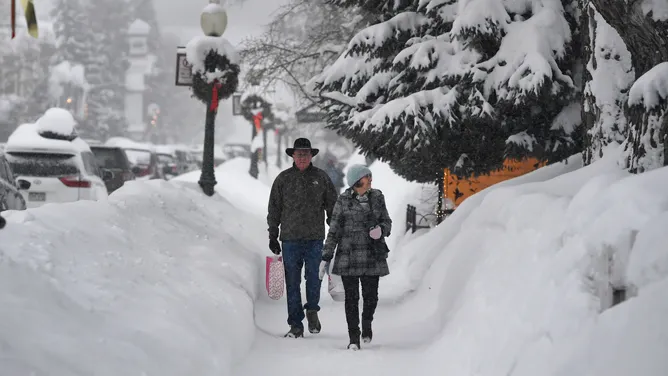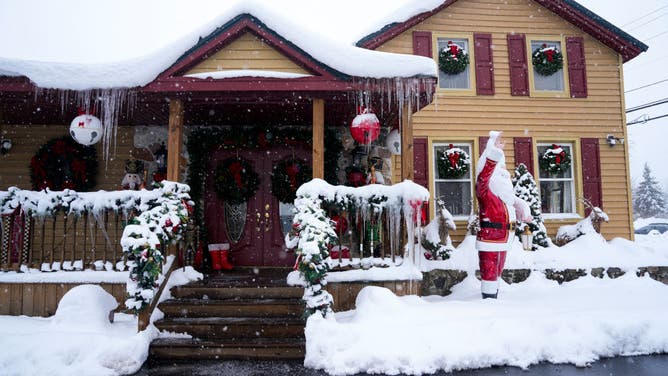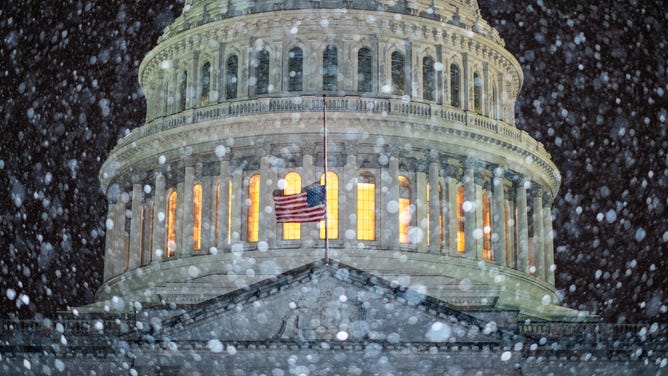What are the odds of a white Christmas?
In order to qualify for a white Christmas, there must either be at least 1 inch of snow on the ground on Christmas morning or falling snow must accumulate to at least 0.1 inches on Dec. 25.
Who could see a white Christmas this year?
There is plenty of snow on the ground two weeks before Christmas but after significant rain the FOX Forecast Center said it might be unlikely for most to see a white Christmas. The last time New York City and DC had a white Christmas was in 2009.
Are you dreaming of a white Christmas?
We all know the classic Bing Crosby song, but what are the odds of this song becoming a reality where you'll be spending the holiday?
To answer that question, FOX Weather has compiled the map below, illustrating the historical probability of a white Christmas across the U.S.

The historical probability of a white Christmas.
(FOX Weather)
In order to qualify for a white Christmas, there must either be at least 1 inch of snow on the ground on Christmas morning or falling snow must accumulate to at least 0.1 inches on Dec. 25. This is the same criteria used by the National Weather Service.
HOW ‘WHITE CHRISTMAS’ BECAME AN ICONIC HOLIDAY SONG
The map is based on historical weather data averaged over the 30-year period from 1991 to 2020, the most recent climatological averages provided by NOAA's National Centers for Environmental Information.
Where is a white Christmas most likely to happen?

A couple walks down the snowy main street as they shop on Jan. 11, 2017, in Crested Butte, Colorado, which is located near Aspen.
(Helen H. Richardson / The Denver Post / Getty Images)
In the Lower 48, the northern and central Rockies, California's Sierra Nevada and the Washington and Oregon Cascades have the highest odds of encountering snow on Christmas Day. The probability of a white Christmas is as high as 90% to 100% in the highest peaks of those mountain ranges.
Aspen, Colorado, is just one of about a dozen locations that can brag about having a 100% chance of a white Christmas, according to NOAA.
There's also a 90% to 100% chance of a white Christmas in portions of northern North Dakota, northern Minnesota, northern Wisconsin and the Upper Peninsula of Michigan.

A silhouetted walker made his way around Lake Harriet in Minneapolis, Minnesota, as falling snow obscured the horizon late Tuesday afternoon, Feb. 22, 2023.
(Jeff Wheeler / Star Tribune / Getty Images)
The odds of Christmas Day snow begin to diminish as both elevation and latitude become lower. However, there's still a 50% or higher probability of a white Christmas across much of the nation's northern tier, from the northern Plains to parts of the Upper Midwest, Great Lakes and interior Northeast.
EXTREME WEATHER TAKES A TOLL ON CHRISTMAS TREE SUPPLY
Minneapolis-St. Paul, Madison in Wisconsin and Burlington in Vermont each have a 60% to 75% chance of a white Christmas in an average year. The odds drop below 50% in cities such as Detroit.
"I-70 is that corridor, really, that we look at and points north where your chances begin to increase," FOX Weather Meteorologist Stephen Morgan said. "So you take I-70, you head north, Chicago, yeah, maybe 50-50 shot that we have through parts of the Upper Midwest for sure."
Who has the lowest chance of a white Christmas?

A statue of Santa Claus is covered in snow outside of a realty business on December 4, 2024 in Watertown, New York. (Photo by Kayla Bartkowski/Getty Images)
(Getty Images)
A white Christmas happens only 10% to 20% of the time along the Interstate 95 corridor of the Northeast.
HOW WEATHER IMPACTS CHRISTMAS LIGHT DISPLAYS
New York City has at least 1 inch of snow on the ground on Christmas morning about once every six years, on average. Farther north, in Boston, the frequency increases slightly to about once every five years. However, white Christmases in Philadelphia, Baltimore and Washington only happen about once a decade.

Snow falls over the U.S. Capitol Building on Monday, Jan. 3, 2022, in Washington, D.C.
(Kent Nishimura / Los Angeles Times / Getty Images)
Most areas along the West and Gulf coasts and in the Deep South have less than a 10% chance of Christmas Day snow because temperatures in those regions don't typically get cold enough to produce measurable snow so early in the winter (if it snows at all during the season).
"Speaking of songs, I think the only one that you'll probably be singing is by Aerosmith – ‘Dream On’ – south of the I-70 corridor," Morgan said. "Chances of a white Christmas, nonexistent. We would have to have a big-time arctic outbreak for that to occur."
Keep in mind that the statistics provided in this story are simply averages. The weather pattern that sets up each December can increase the chances of a white Christmas in some areas while decreasing those odds in other areas.
'White Christmas': The true story behind the most successful song ever
First performed by Bing Crosby, 'White Christmas' has been defining the holiday season for 80 years and counting.

